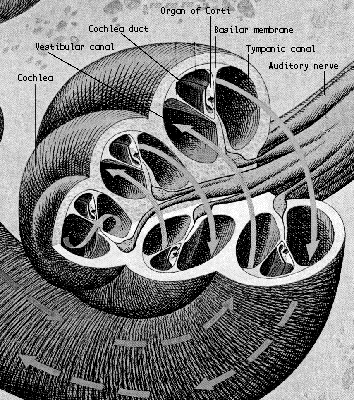
The Inner Ear : The Cochlea.
The amplified mechanical force transmitted from the middle ear to the inner ear by
the ossicles is immediately transformed in the cochlea into hydraulic pressure. This
hydrolic pressure imparts movement to the cochlear duct and to the organ of Corti
- the "peripheral seat of hearing". This process is acomplished in the
cochlea which is no bigger than the tip of a little finger.
A cross-section of the cochlea shows its vestibular canal, tympanic canal and cochlear duct.

THE COCHLEA.
[Stevens, 1980]
The vestibular and tympanic canals contain perilymph - a liquid almost identical with spinal fluid. The cochlea duct contains endolymph - a liquid similar to the fluid within cells. The canals are separated by thin membranes: Reissner's membrane between the vestibular canal and the cochlea duct is the thinnest (just 2 cell walls thick), and the basilar membrane between the tympanic canal and the cochlear duct.
The perilymph and endolymph have differing chemical compositions and electrical charges. Any break in the membranes that allows them to mix impairs the hearing process.
How the Cochlea works.
The pressure waves in the cochlea exert energy along a route that begins at the oval
window and ends abruptly at the membrane-covered round window, where the pressure
is dissipated. Inkeeping with the principles of hydraulics, the pressure applied
to the oval window at the stirrup is transmitted to all parts of the cochlea.
The semicircular canals are the body's balance mechanism and it is thought that it plays no part in hearing.
One of the two walls of the cochlear duct is the vibrating basilar membrane whose function is to separate sounds according to frequency. The membrane is narrow and taunt at the end near the stirrup and wider and more pliant at the other.
Hydraulic pressure waves in the cochlea induce a wave-like ripple in the basilar membrane which travels from the taunt towards the loose end. High tones create their greatest crests where the membrane is tight, low tones where the wall is slack. This is because resonant frequency is correlated with tension as in a taunt string. The position of this crest is important because it determines which nerve fibres will send signals to the brain. High frequency tones cause the crest to occur at the base of the cochlea and the lower frequencies towards the apex.
Apart from airborne sounds, the basilar membrane also picks up vibrations in the skull from such sources as teeth clicking, for example.